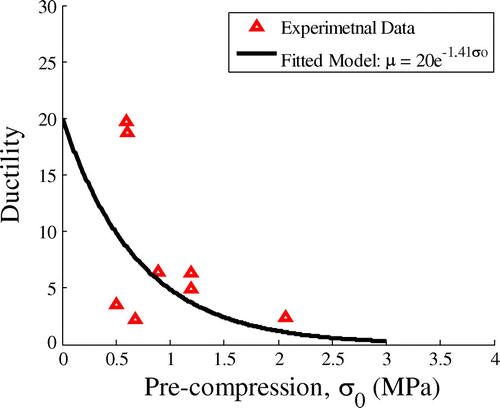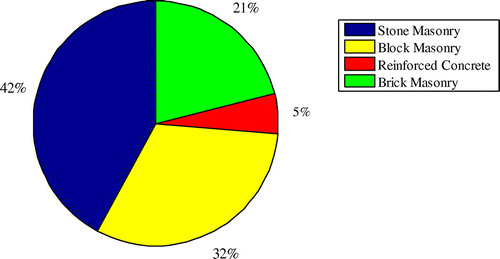 ?Mathematical formulae have been encoded as MathML and are displayed in this HTML version using MathJax in order to improve their display. Uncheck the box to turn MathJax off. This feature requires Javascript. Click on a formula to zoom.
?Mathematical formulae have been encoded as MathML and are displayed in this HTML version using MathJax in order to improve their display. Uncheck the box to turn MathJax off. This feature requires Javascript. Click on a formula to zoom.Abstract
Seismic fragility functions provide an easy mean to estimate the vulnerability of structures, develop damage scenarios and quantify number of structures with different damage states for a given seismic hazard. This paper presents the derivation of fragility functions for different types of masonry structures in Pakistan using a European standard methodology. It included structures with reinforced concrete floors and wooden/steel floors with truss roof. The first class of masonry structures is considered with the in-plane shear damage in masonry walls with abrupt collapse of structure at the ultimate deformation capacity of in-plane walls. Masonry structures of second class are considered with the collapse of out-of-plane façade walls in case of the absence of ring beams and ties and presence of weak wall-to-wall and wall-to-floor connections. Monte Carlo simulation is used to generate random structures with different geometrical and mechanical properties, which are analyzed using fully probabilistic approach in order to assess their seismic vulnerability. The number of structures exceeding different damage states are quantified to compute the limit state exceedance probability correlated with the seismic intensity measure, mainly inelastic spectral displacement, peak ground acceleration and spectral acceleration at 0.30 s, to derive family of analytical fragility functions. The derived fragility functions are tested and validated against the recent 2005 Kashmir earthquake, which shows reasonable prediction performance. The derived fragility functions can be used to derive damage probability matrices and estimate socio-economic losses in the region for public awareness and community earthquake preparedness planning in order to mitigate future earthquake regional risk.
Public Interest Statement
Human casualties and economic losses due to natural hazards worldwide are on rise, which are primarily due to high vulnerability of structures and infrastructures. The goal of risk mitigation is to strengthen the physical infrastructures and enhance their seismic capacity to resist future earthquakes with minimal damages. However, this becomes idealistic considering regional scale, because retrofitting the entire nation is unachievable due to the high cost involved. Risk assessment of infrastructures is a parallel activity to prioritize the budget utilization, which requires probabilistic damageability assessment fragility functions. These mathematical functions involved correlating physical damages incurred by structures given the ground motions severity, which requires a nonlinear assessment procedure for seismic performance evaluation of structures. This paper presents a nonlinear static displacement-based procedure for seismic assessment and derivation of fragility functions of structures with application to urban masonry buildings for both global (in-plane) damage mechanism and local (out-of-plane) failure mechanisms.
1. Introduction
The recent experiences of earthquake observations have demonstrated the high vulnerability of existing construction types in Pakistan and their socio-economic impacts on the built environment (Ambraseys, Lensen, & Moinfar, Citation1975; Asian Development Bank and World Bank [ADB-WB], Citation2005; Maqsood & Schwarz, Citation2010; Naseer, Khan, Hussain, & Ali, Citation2010; Rossetto & Peiris, Citation2009). The drastic consequences of earthquake events in Pakistan is also attributed to the fact that the site seismicity was underestimated by seismic design codes as demonstrated by recent seismic events (Naseer et al., Citation2010; Rossetto & Peiris, Citation2009), whereby in most cases seismic design of structures is ignored in the region, and the lack of awareness and preparedness in the country (Khan, Citation2007). High death toll in these earthquakes demonstrate also the social vulnerability of inhabitants i.e. the relative deaths caused by earthquakes in Pakistan is higher than that of other parts of the World (Ahmad, Citation2011).
Following the recent 2005 Kashmir earthquake, which destroyed 80,000 buildings (Earthquake Engineering Research Institute, Citation2006) and caused an overall economic loss of about USD 6 billions (ADB-WB, Citation2005). The current new construction practice in the country went a major overhaul, mostly in the Kashmir earthquake affected regions. However, much urban exposure, which is not subjected to large earthquakes in near past, still has significant amount of such vulnerable structures. Also due to the low economic status of the inhabitants, old traditions and lack of public awareness, these construction types are still in use in many parts of the country. Also, recent investigation on the ground motions estimation has shown that many parts of the country may be subjected to very large ground shaking than code specified (Building Code of Pakistan, Citation2007; Zaman & Warnitchai, Citation2010). While it is true that ordinary masonry structures designed to meet the minimum requirements of earthquake-resistant structures or retrofitted with modest effort can perform significantly well in case of low-to-moderate seismic regions (Magenes, Citation2006). It is also important to develop tools and guidelines for seismic risk assessment of structures against future large earthquakes for public awareness, code enforcement, insurance and re-insurance modelling and earthquake preparedness for prompt response in order to mitigate the regional expected disasters. As the use of advanced construction techniques may require significant time to be adopted widely in the country, risk assessment of structures is a parallel activity in order to help guide decision makers for better policy-making in the country.
This paper presents a simplified nonlinear static analytical method, displacement-based (Crowley, Pinho, & Bommer, Citation2004), for seismic vulnerability assessment of structures subjected to ground motions. The method uses the basic principle of the mechanics of materials and structures to assess the seismic vulnerability of group of structures on regional scale taking into account the expected variability in the geometrical and mechanical properties of the structural systems. The emerging concepts of performance-based engineering for masonry made it possible to calibrate the aforementioned methodology for such building systems as well. The calibration of the method is performed for residential masonry structures in urban areas of Pakistan. Nonlinear static and dynamic time history analysis of case study structure models are performed in order to quantify their seismic response parameters. Experimental data is obtained from the available literature and the recent experimental investigation on masonry material and reduced/full scale structural elements and models. Analytical seismic capacity curves and fragility functions are derived for the case study structure types. Fragility functions are correlated with different seismic intensity for future applications include mainly inelastic spectral displacement demand, spectral acceleration at 0.30 s and peak ground acceleration (PGA). The methodology and the derived fragility functions were tested against the recent 2005 Kashmir earthquake, which showed reasonably efficient performance in structures’ damage prediction, thus validating the methodology and the fragility functions.
2. Behavior of masonry structures to ground shaking
2.1. Generalities
The construction practice for masonry structure in moderate to high seismic regions will greatly vary among different countries and within a country depending on the local practices, moving from rural to urban area. The discussion herein is limited to the residential unreinforced and unconfined masonry structures, which is equally valid for very lightly reinforced masonry for which there is no significant difference in the seismic behavior from its unreinforced counterpart.
Before assessing the seismic performance of masonry structures, the behavior of this structure type to seismic loading should be made understood. The behavior of masonry material is dramatically different than the counterpart concrete and steel material due to high non-homogeneity and composite nature of masonry components. The different mechanical properties of masonry units and mortar and their interface makes the masonry behavior difficult to predict, which becomes almost impossible in the context of seismic assessment of existing structures. Thus, the masonry system behavior can be best understand through the available literature based on the experimental results and/or the observations from earthquakes whereby such findings can be extended to predict the most likely behavior and performance of other existing structures.
2.2. Seismic response mechanisms of masonry structures
Masonry structures are often composed of several load-bearing walls in orthogonal directions. When the connection at wall intersections and at floor-to-wall is achieved through proper means with controlled out-of-plane deflection of the floors, the building primarily resist the lateral loads by the in-plane response of walls (Magenes, Citation2006). The structure thus may respond either in a storey mechanism, for the case of weak piers and strong spandrels, or spandrel mechanism, for the case of weak coupling elements and strong piers, see Figure . It has to be noted that the failure mechanism significantly affects the seismic capacity of a masonry structure resulting in different level of vulnerability against earthquake loading (Magenes & Morandi, Citation2008; Morandi & Magenes, Citation2008).
Figure 1. Global failure mechanisms of masonry structures.
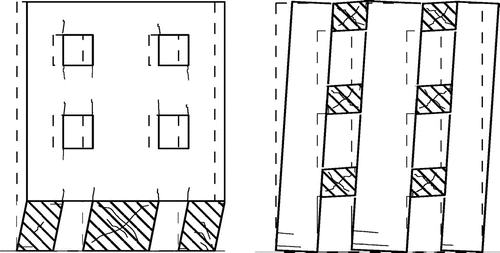
The provision of rc slab, presence of tie rods, ring beams at floor levels and efficient floor-to-wall connections favours the integrity of masonry walls enabling the structure respond in a box like action to seismic excitations with shear dominated damage of masonry walls (Magenes, Citation2006; Tomazevic, Citation1999). Flexure rocking of masonry, walls in different typologies, is also a possible mechanism to resist lateral load (Abrams, Citation2001; Galasco, Magenes, Penna, & Da-Pare, Citation2010; Magenes & Calvi, Citation1997).
The structural system provides energy dissipation, due to nonlinear behavior of masonry walls, and certain level of ductility capacity and having degrading stiffness and strength characteristics. The nonlinear response is relatively more ductile and dissipative for weak mortar to strong masonry unit, where the damage cracks follow the head- and bed-joint mortar, which is rapidly degrading and relatively brittle in the case of weak masonry units where the damage cracks developed passes through units. For most real cases the actual damage pattern is in-between where the damage cracks developed passes the units and mortar in a more or less complex pattern.
Masonry structures without rc slabs, ring beams and tie rods having orthogonal walls not properly connected, or due to loss of in-plane walls integrity during seismic excitations, respond in local out-of-plane collapse of portion of walls or complete walls as evidenced in most of the historic towns during earthquakes (D’Ayala & Paganoni, Citation2011; D’Ayala & Speranza, Citation2003; Magenes, Citation2006), see Figure .
Figure 2. Observed out-of-plane failure modes for masonry structures (D’Ayala & Speranza, Citation2003).
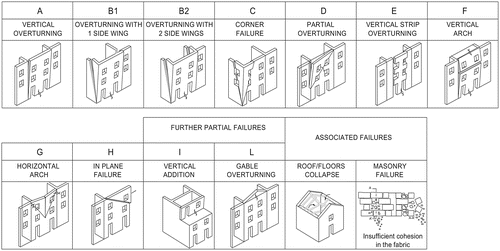
Some of these structure types when shaken by ground excitation can promptly exhibit the out-of-plane collapse of wall materials to complete collapse of walls without any significant damage in the in-plane walls (Restrepo-Velez & Magenes, Citation2009). However some of these structures may exhibit delamination and/or progressing collapse of masonry walls, e.g. as common with rubble masonry, after developing damage in the in-plane walls i.e. the in-plane capacity of walls are developed first. This last category of structure type shows progressing collapse of masonry units followed by the complete collapse of structures i.e. coupled in-plane/out-of-plane damage mechanism. This type of damage has been observed in Europe (both in 1995 Aegion earthquake and 1999 Athens earthquake), see Figure , and also recently in 2005 Kashmir earthquake for masonry structures with rc slab roof as well as for wooden/steel roof truss structures, see Figure . The present study will consider the global in-plane mechanism and local out-of-plane mechanisms for masonry seismic assessment. The out-of-plane delamination of material is not considered due to the fact that such failure of material does not jeopardize the global stability of structure.
Figure 3. Damage mechanisms of rubble stone masonry.

3. Seismic risk assessment of masonry structures
3.1. Displacement based earthquake loss assessment methodology, DBELA
The present study considered the DBELA a European standard methodology for vulnerability assessment of structures on regional scale and the derivation of family of analytical fragility functions. The methodology makes use of the existing displacement based approaches, developed mainly for the design and assessment of structures at the University of Pavia, EUCENTRE and ROSE School-IUSS Pavia and calibrated herein for case study unreinforced masonry structures. The displacement-based method is originally proposed and developed elsewhere for rc and masonry structures (Bommer, Pinho, & Crowley, Citation2006; Borzi, Crowley, & Pinho, Citation2008; Borzi, Pinho, & Crowley, Citation2008; Calvi, Citation1999; Crowley & Bommer, Citation2006; Crowley, Pinho, Bommer, & Bird, Citation2006; Glaister & Pinho, Citation2003; Restrepo-Velez & Magenes, Citation2004). However, it is further developed for structures in Pakistan considering their global (in-plane mechanism) and local (out-of-plane mechanism) vulnerabilities.
The main theme of the methodology is to derive fragility functions for different classes of structures, taking into account both their global and local vulnerability, and their corresponding mechanical models (defined completely by secant vibration period, viscous damping and limit state displacement capacities), in a probabilistic fashion; considering the variability in the geometric and material properties of the structures in an explicit manner besides the variability in the seismic demand. The method is capable to take into account the record-to-record variability introduced into the system mechanical parameters by earthquake loading. Having fragility functions on one hand and mechanical models on the other, intensity-based (code spectra), scenario-based (historical earthquakes) and time-based (annualized losses, loss exceedance curves through uniform hazard spectra) losses on regional scale can be computed by knowing only the seismic demand on the SDOF system (having median mechanical characteristics).
Although the earthquake losses need to be computed using scenario earthquakes in order to respect the realistic shape of the spectral demand for an earthquake event (Bal, Citation2008; Bommer et al., Citation2002). To facilitate different users and wide case study applications, family of fragility functions are also derived correlated mainly with peak ground acceleration, spectral acceleration at 0.30 s and the possibility for using instrumental-intensity. The spectral acceleration-based, at 0.30 s, fragility functions, as substitute of vector-based fragility functions, can be also used reasonably for scenario-based loss estimation and for estimation of average annual losses for the considered masonry structures which are relatively sensitive to low period (high frequency) ground motions.
3.1.1. Fundamentals of the methodology
The methodology make use of analytical fragility functions and a mechanical model for building stock, which is represented as a nonlinear static single degree of freedom (SDOF) system to seismic demand, develop damage scenario for regional seismic risk assessment and socio-economic impacts analysis for a given earthquake event. The seismic demand on structures is defined by 5 percent damped displacement response spectrum using code-based (for intensity-based), GMPE-based (for scenario earthquakes) and/or UHS-based (for estimation of loss exceedance curve and annualized losses) spectrum representation depending on the scope of the study. Where GMPE stands for ground motion prediction equation and UHS stands for the uniform hazard spectra. To better understand the methodology it is depicted graphically Figure .
Figure 4. Graphical representation of DBELA.
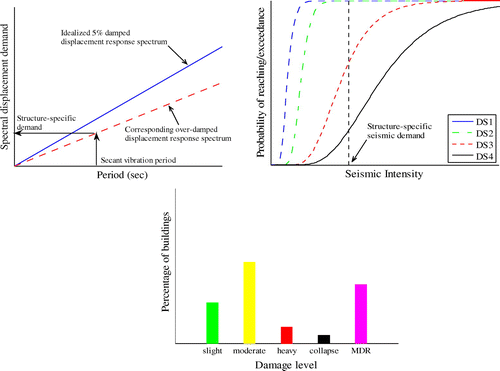
In this methodology, the first step is to generate 5 percent damped elastic displacement response spectrum for a given earthquake, intensity, etc. which is analyzed (overdamped in an iterative fashion) to compute the structure-specific seismic demand (vector-based seismic intensity for the case of inelastic displacement-based fragility functions) at the secant vibration period of the structure. The seismic intensity is used to compute the number of structures in different damage states from the analytical fragility functions in order to develop damage scenarios and quantify the number of structures expected in different damage states i.e. slight damage, moderate damage, heavy damage and collapsed etc.
The number of structures in different damage states can be transformed to mean damage ratio (MDR); which quantify the regional seismic risk and gives an estimate of direct economic losses for the considered earthquake. The conversion of structure damage states to MDR is performed using an appropriate earthquake loss model e.g. the model proposed by FEMA (Federal Emergency Management Agency, Citation2003) for USA and developed by Bal (Bal, Crowley, Pinho, & Gulay, Citation2008) for Euro-Mediterranean regions in general and Turkey in particular. Other studies included mechanics based economic loss models, which can be used to predict the economic loss that structure can incur given the damage in structural components (Xue, Wu, Chen, & Chou, Citation2009). However such models are used essentially in the post-earthquake phase for screening the structures, needed to be retrofitted economically and others to be demolished.
3.2. Mechanical models for structures in DBELA
The methodology uses SDOF systems, called a mechanical model, having nonlinear lateral force-displacement response to assess the seismic performance of structures. The mechanical model simulates the response of the structural system in terms of its displacement capacity, energy dissipation and secant vibration period for seismic assessment. For each material type the methodology broadly classify masonry structures in two major classes based on the predominant seismic response mechanism during an earthquake: global mechanism for structures with in-plane and/or local mechanism for structures with predominant out-of-plane failure modes. The following section describes the hypothesis used for the vulnerability assessment of masonry structures and the derivation of fragility functions correlated with different seismic intensity.
3.2.1 Global mechanism
An equivalent SDOF system is used to simulate the global response of structures in terms of displacement capacity, viscous damping and secant vibration period at different damage states for performance evaluation given an earthquake event, represented as 5 percent damped elastic displacement response spectrum. Figure the idealization of a masonry structures with an equivalent SDOF system.
Figure 5. Nonlinear static SDOF idealization and capacity curve, mechanical model, for global mechanism.

where HT represents the total structure height; hi represents the ith floor height, Δi represents the lateral displacement and mi represents the ith floor mass, masses from walls are lumped at floor in addition to the floor self weight, for a given deformed shape of building; Me and He represent mass and height of the equivalent SDOF system; Δy and ΔLS represent the equivalent yield and ultimate limit states displacements that represents the displacement capacity of the actual structures at the center of seismic force for a specified deformed shape; Ki represents the initial pre-yield stiffness; Fy represents the yielding force; Ksec represents the secant stiffness; α represents the post-yield stiffness to the initial stiffness ratio, which can be positive/negative to represent hardening/softening behavior of structures, which is considered zero for the case of in-plane mechanism of structures and which corresponds to the idealized bi-linear capacity curve of that structure. It is can be considered positive for the structures with progressing out-of-plane collapse of walls, the removal of material causes the reduction in seismic mass and hardening effect of capacity curve (Ali et al., Citation2010). However, in case of global analysis with torsion in the structures, a negative value can be observed, whereby the structure shows relatively high vulnerability to its counterpart structure without torsion (Ahmad, Crowley, Pinho, & Ali, Citation2010a).
It is worth to mention that the force-displacement response of structural systems is represented in terms of equivalent lateral strength and equivalent displacement capacity i.e. capacity curve. The lateral strength of structures is normalized by the seismic mass participation i.e. equivalent mass, where equivalent mass is obtained by normalizing the floor masses over the deformed shape of the buildings. The deformed shape of a structural system is obtained through a parametric case study nonlinear time history analysis of structural models, without pre-assumptions, which also help to quantify the record-to-record variability in the displacement capacity and secant vibration period. For seismic assessment, the mechanical model is completely defined by secant vibration period, limit state displacement capacity and energy dissipation characteristics of structures represented as viscous damping.(1)
(1)
(2)
(2)
(3)
(3)
(4)
(4)
(5)
(5)
(6)
(6)
where TLS represents the limit state secant vibration period; Ty represents the yield vibration period; a and b represent coefficients, having distinct values for different structural systems; σ represents the total logarithmic standard deviation, which is the measures of period variability for given class due to uncertainties in material and geometric properties and record-to-record variability; ε number of standard deviation above/below mean value; μ = ∆LS/∆y represents the limit state ductility; ∆y represents the yield displacement capacity; ∆LS represents the specified limit state displacement capacity; θy represents the inter storey yield drift; θLS represents the specified limit state interstorey drift; θW represents the inter storey drift corresponding to the limit state drift of spandrels θS; HT represents the total height of building; hs represents the story height; D represents the length of wall; LS represents the length of spandrel; k1 & k2 represent the displacement coefficients to convert multi degree of freedom (MDOF) structural system to an equivalent SDOF system and simulate the displacement capacity of MDOF system at the center of seismic force (Bal, Citation2008; Calvi, Citation1999; Priestley, Calvi, & Kowalsky, Citation2007; Restrepo-Velez & Magenes, Citation2004); ξeq represents the equivalent viscous damping of structural system; ξel represents the elastic damping of the system (pre-yield); ξhyst represents the hysteretic contribution of system damping due to nonlinear response of structural components, different values can be assigned to coefficient C depending on the structural capability to dissipate seismic energy (Priestley et al., Citation2007). The limit state parameter values are selected, considering a given damage scale (Bal, Citation2008; Bal et al., Citation2008; Calvi, Citation1999; Crowley et al., Citation2006; Restrepo-Velez & Magenes, Citation2004) to predict the corresponding damage states of structures for the derivation of fragility functions.
The drift limits can be defined for different structural systems using experimental (obtained from laboratory investigation on model walls and structures) models 00, or analytical (based on masonry compression strain limits which are used to obtain section curvature, wall chord rotation and interstorey drifts) as proposed by Kappos 0 for Greek masonry, empirical model (Javed, Citation2008), or numerically using more or less sophisticated tools recommended by experts as employed by (Bal, Citation2008); HT represents the height of the system.
3.2.2. Local mechanism
Similarly, SDOF system is employed for the vulnerability assessment of masonry structures with out-of-failure modes of masonry walls. The methodology for the out-of-plane assessment is a displacement-based approach for which the mechanical is formulated following the recommendations of Doherty, Griffith, Lam, and Wilson (Citation2002), see Figure .
Figure 6. Nonlinear static SDOF idealization, mechanical model, of masonry wall for out-of-plane failure modes, after Doherty et al. (Citation2002).

where ai represents the peak acceleration of input excitation; ar represents the response acceleration of wall; M represents total mass of wall; g represents acceleration due to gravity; t represents the wall thickness; ∆1, ∆2 and ∆LS represent the limit state displacement capacities of masonry walls that corresponds to the cracking, joint opening and collapse of wall (Doherty et al., Citation2002). The methodology considers the ultimate displacement capacity as the controlling parameter to define the collapse of the wall.
The resistance of local out-of-plane mechanism to earthquake excitation is governed by the wall geometry, boundary condition, selfweight and pre-compression level of rocking portion of wall while less affected by the masonry material properties 0. The out-of-plane stability and collapse of pre-cracked wall can be relatively well assessed by using the secant stiffness i.e. Ksec, at the beginning of the third degrading branch of the mechanical model, and 5 percent damped elastic floor response spectrum 0. Thus, the secant period for out-of-plane mechanisms can be formulated as follow:
(7)
(7)
where c = ∆2/∆ul represents the ratio of the limit state displacement capacity; ∆2 represents the displacement capacity at the bed-joint crack opening; ∆ul represents the displacement capacity at the collapse limit state; λe = F/Me represents the effective collapse multiplier having unit m/sec2, and can be obtained for the identified collapse mode using the strength models developed analytically and/or empirically (D’Ayala & Speranza, Citation2003; Restrepo-Velez & Magenes, Citation2009); F represents the force at incipient rocking; Me represents the effective seismic mass of wall; t represents the wall thickness; The ultimate displacement capacity of the out-of-plane wall is mainly governed by the thickness of the wall, however a factor of 0.8 is recommended to respect the actual boundary condition and reduce conservatively the ultimate displacement capacity (Griffith, Magenes, Melis, & Picchi, Citation2003; Restrepo-Velez & Magenes, Citation2004), which can be used with 5 percent viscous damping for seismic assessment and collapse prediction. The above equation considers the displacement capacity at the center of seismic force.
3.3. Derivation of fragility functions
Fragility functions, also called fragility curves, vulnerability curves and/or structures damage functions, describe the number of structures reaching or exceeding a given damage state given the seismic intensity; represented as peak ground shaking parameters or spectral quantities (Kircher, Nassar, Kustu, & Holmes, Citation1998). Considering different possible damage states of structures, there could be number of fragility functions for a given typology which can be used to estimate the number of structures in different damage level for a given earthquake event. Generally, for a given limit state, fragility function is derived considering a standard normal cumulative distribution function of the logarithmic difference of the seismic intensity and threshold capacity of limit states with certain level of standard deviation:
(8)
(8)
where P[..] represents the probability of reaching or exceedance a given limit state; Φ represents the standard normal cumulative distribution function; SD represents the seismic intensity/demand; represents the limit state capacity of the system; β represents the natural logarithmic standard deviation which define the level of uncertainties in the fragility function. The limit state capacity
, usually median value, is obtained experimentally or numerically using sophisticated numerical tools.
The standard deviation β is generally obtained from the square root square sum or similar combination of individual uncertainties, which do not have clear rationale and justification behind. Similar other procedures exist which make use of constraint criterion to derive analytical fragility functions. Also, these fragility functions are used in conjunction with median capacity curve for a given structural typology for which no hypothesis are explicitly available to clarify the relation between the performance point, seismic demand on capacity curve for a given earthquake event, and the intensity of fragility functions. Thus, an explicit approach is used to derive analytical fragility functions for group of structures, taking into account different sources of local uncertainties explicitly, without making use of any constraint, in order to obtain the global uncertainty of fragility functions i.e. β, proposed by Ahmad, Crowley, Pinho, and Ali (Citation2010). The flow charts for the vector-based fragility functions are presented in Figures and , which are discussed briefly as follow.
Figure 7. Flow chart for the derivation of vector-based displacement-based fragility functions, global mechanism.
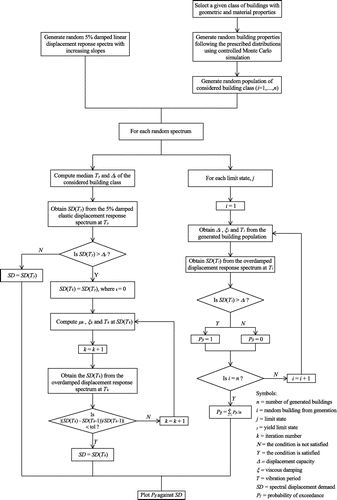
Figure 8. Flow chart for the derivation of vector-based displacement-based fragility functions, local mechanism.
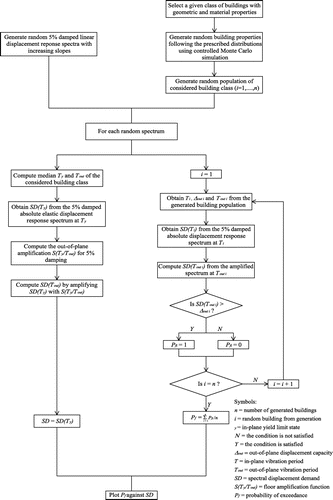
3.3.1. Global mechanism
For global mechanism, the method used Monte Carlo simulation to generated thousands of SDOF systems, representative of the case study regional structures in terms of secant vibration period and limit state deformation capacities. A suitable damage scale is considered based on empirical/analytical models which describe the damage extent with increase in deformation demand which is employed to compute the limit state displacement capacity and vibration period using the analytical model presented earlier. Different SDOF thus generated is compared for the displacement capacity demand check at the secant vibration period, using linear displacement response. For a given limit state, the number of SDOF having capacity less than the demand is divided by the total number in order to obtain the limit state probability of exceedance which is correlated then with the inelastic displacement demand on the median/mean SDOF system in order to derive vector-based fragility functions. Scalar fragility functions make use of SA (0.30 s) or PGA. However a code-based spectrum can be employed conveniently instead of linear displacement response spectra for fragility functions in terms of PGA.
3.3.2. Local out-of-plane mechanism
The general methodology for out-of-plane vulnerability assessment and fragility functions derivation is essentially the same. However, the seismic demand on the out-of-plane loaded wall is rather complex (Priestley, Citation1985) thus the 5 percent damped elastic displacement spectrum can be extended for out-of-plane assessment.
Generally, the structures are predominantly excited in orthogonal directions by real seismic excitations, with translation and rotational motions. The structural component walls are subjected to loadings in both principal directions. The in-plane walls at the structure edges transmit the ground motion to the floors which is taken further to out-of-plane walls, see Figure . Thus the out-of-plane loaded walls are subjected to ground motions which are essentially filtered by the in-plane walls and floor of structure. Due to significant mass participation, the walls are excited in the out-of-plane direction, perpendicular to the width, due to high inertial demand. If the minimum criterion, set forth by Magenes (Magenes, Citation2006), is not satisfied for a masonry structure. The structure will not behave in a box-like actions thus the component walls will be subjected to seismic loading in the out-of-plane direction in any prevailing mechanism commonly observed (D’Ayala & Paganoni, Citation2011; D’Ayala & Speranza, Citation2003). Such prevailing mechanism can be identified also using the diagnostic flow chart developed by Restrepo-Velez (Citation2004).
Figure 9. Definition of seismic demand on the out-of-plane walls.
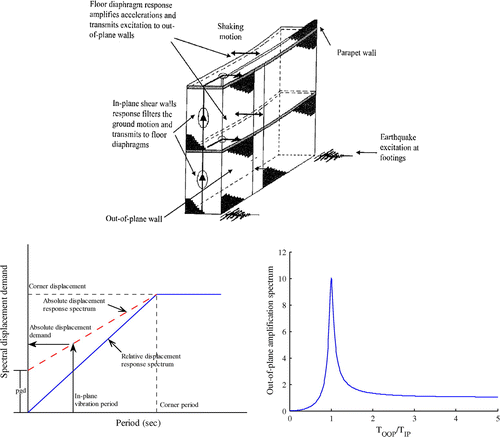
In the present methodology the seismic demand on the out-of-plane façade wall is defined through the use of an absolute linear displacement spectrum and the out-of-plane amplification spectrum, following the recommendation of Priestley et al. (Citation2007), which takes into account the dynamic filtering effect of ground motions by structures whereby the relative displacement spectrum is modified to define displacement demand on the out-of-plane walls.
(9)
(9)
where Soop represents the out-of-plane amplification factor to amplify the absolute displacement spectrum; TOOP represents the secant period of out-of-plane wall; TIP represents the in-plane secant period of structure; ξOOP represents the viscous damping of out-of-plane responding wall, recommended as 5 percent (Griffith et al., Citation2003). The relative and absolute displacement spectra and out-of-plane amplification spectrum used for in-plane and out-of-plane assessment are depicted in Figure .
Figure 10. Equivalent frame method.

The absolute spectrum is anchored at the peak ground displacement (pgd) and linearly increased to maximum displacement demand at the corner period following the recommendation of Priestley (Citation1985). Different recommendations can be used to compute the pgd, corner period and corner displacement for worldwide regions among others. However, in the present study for the out-of-plane fragility function derivation the pgd and the slope of absolute displacement spectrum are randomly selected using Monte Carlo simulation while increasing the spectrum linearly, against the period, without any bound for convenience. Nevertheless, an appropriate displacement spectra, both relative and absolute, has to be used for developing damage scenarios for intended loss estimation study in case of vector-based fragility functions. Later applications can be simplified using scalar intensity parameter like PGA, SA (0.30 s).
4. Developing fragility functions for masonry structures
The derivation of fragility functions for case study masonry structures include the essential development of the DBELA method for these target construction types. The development mainly aims to develop the aforementioned analytical models for limit state displacement capacity and secant vibration period for each construction types. Such calibration required to be performed in light of regional material and structural characteristics. The following section presents the development of methodology for case study masonry structures.
4.1. Mathematical modeling for masonry structures, global assessment
4.1.1. Modelling hypothesis, equivalent frame method (EFM)
The secant period of masonry structures is influenced by the lateral stiffness and strength of structures. Thus lateral force-displacement response, capacity curve, of structures is required which can be used then for the assessment method development. The method used for the mathematical modelling and nonlinear pushover analysis of masonry structures in the present study is based on the equivalent frame idealization of masonry walls with rigid offsets as proposed earlier by Magenes and Fontana (Magenes & Fontana, Citation1998) for the simplified global analysis of masonry structures. The present study formulated the method with simplified constitutive laws, supported masonry shear strength models, for frame elements representing piers and spandrels which can be applied to any type of masonry structures i.e. unreinforced, reinforced and confined, with regular openings and rigid or flexible floors. Different strength models can be employed in the case of reinforcement and confinement. The method uses the idea of modelling masonry spandrels and piers as one-dimensional beam-column elements with bending and shear deformation with infinitely stiff joint element offsets at the ends of the pier and spandrel elements, Figure . The method has been developed and employed for many different types of masonry structures within the context of seismic vulnerability and risk assessment essentially considering global mechanisms. A similar type modelling approach, constitutive law being defined at the section level, is also used by Kappos, Penelis, and Drakopoulos (Citation2002) for the vulnerability assessment of masonry structures.
The effective deformable length of pier is approximately obtained taking the intersection of the element with a line making a 30 degree angle with the corners of the openings. Each of the elements are provided with lumped nonlinear hinge having an appropriate force-displacement rule to simulate the lateral response of masonry wall, depending on the wall ultimate mechanism predicted using the aforementioned strength models. The frame element responds in flexure bending, with elastic shear deformation, (in force-controlled mode) and yields when its ultimate capacity is reached in shear, whereby the wall respond in displacement-control mode. The failure occurs in the wall when its ultimate displacement capacity is developed in the element, thus very compatible with the physical damage mechanism in masonry walls. The total displacement capacity of the element at any instant is the summation of the bending and shear deformation developed in that element where the flexure deformation is contributed by the bending of the frame element and the shear deformation is contributed by the hinge assigned to the frame. Deformation due to additional in-plane local mechanisms: slippage at bed joints and rigid-body rotations can also be taken into account.
4.1.2. Frame elements constitutive law
Following the comparison of available shear strength models for masonry walls against the quasi-static cyclic tests on full scale walls at the Earthquake Engineering Center, the following strength models is found to provide best estimate of masonry shear for the case study masonry structures, due to the prevailing mechanism of considered structures. It is worth to mention that other recommended masonry shear strength models for rocking mechanism and shear sliding mechanisms are also used, however the following model always resulted in lower shear capacity, which is considered conservatively.(10)
(10)
where ftu represents the principal tensile strength, also called diagonal tensile strength; p represents the mean normal stress on wall; D represents the wall length; t represents the thickness of the wall; b represents the coefficient used to approximate the complex shear stress distribution in masonry wall; Vd represents the lateral load carrying capacity of the wall for the considered mechanism.
The coefficient b varies with the aspect ratio of the pier. A simple criterion is proposed (Benedetti & Tomazevic, Citation1984) to evaluate b: b = 1.5 for H/D ≥ 1.5, b = 1.0 for H/D ≤ 1.0 and b = H/D for 1 < H/D < 1.5. The diagonal tensile strength of masonry is a global strength parameter and can be obtained performing diagonal shear test on masonry panel by knowing the maximum vertical load at the onset of diagonal cracks in the panel. The diagonal tensile strength is then computed using Equation (11):
(11)
(11)
where N represents the ultimate vertical load at the onset of diagonal cracking in the panel; t represents the thickness of the panel; l1 and l2 are the length of the two respective sides of the panel.
The above equation is an approximation of the model proposed by frocht (Frocht, Citation1931) and which is also recommended by RILEM (Rilem, Citation1994), where the constant value of 0.52 (in the original proposal) is replaced conservatively by 0.50. Alternatively, ftu can be obtained from the maximum shear strength of masonry wall, when the wall fails due to the formation of diagonal inclined cracks in the wall using Equation (12) and/or from the compressive strength of masonry using Equation (13), empirical rule proposed on the bases of large sets of experimental results by Tomazevic (Tomazevic, Citation1999).
(12)
(12)
(13)
(13)
where τmax represents the shear stress obtained when the principal stress at the center of the pier reaches the tensile strength of masonry; fm represents the compressive strength of masonry.
For all the frame elements the yield force is considered to be 90 percent of the value estimated using the above strength models based on the experts recommendations (Magenes & Calvi, Citation1997) for the possible bi-linearization of non-linear capacity curves for masonry walls. The analysis of masonry structures is performed in OpenSees (McKenna, Fenves, & Scott, Citation2010). The beam-column element used for masonry idealization is completely defined by masonry Young modulus, shear modulus, wall sectional area and the wall moment of inertia. The hinge, defined through zerolength element and hysteretic material assigned with nonlinear force-displacement constitutive law to simulate the lateral capacity of the masonry wall.
The nonlinear behavior, force-displacement response of the frame element is idealized as elastic-perfectly-plastic for the masonry piers as per recommendation by other researchers (Magenes & Calvi, Citation1997; Tomazevic, Citation1999) and used also elsewhere (Magenes, Citation2000) for nonlinear pushover analysis and NLTHA (Menon & Magenes, Citation2011) with a limited deformation capacity at which the strength of the element goes to zero (defining the failure of element). It is worth to mention that due to the provision of rc slab, ring beam and lintel bands the horizontal coupling elements (spandrels) do not yield for the case study structures and is thus considered as elastic. The present study considered the force-displacement constitutive law for frame elements (walls) with Takeda-Type rule of Otani (Otani, Citation1974) having Emori type of unloading (Emori & Schnobrich, Citation1974), see Figure .
Figure 11. Lateral force-displacement response of case study masonry walls.

where Fy represents the yield strength obtained using the above strength model for masonry walls, reduced by 10 percent; ki represents the initial 50% crack stiffness, (ks + kf); ks represents shear stiffness, kf represents flexure stiffness; ∆y represents the idealized yield displacement, (∆yh + ∆yf); ∆yh represents the shear deformation, simulated through shear hinge; ∆yf represents the flexure deformation, simulated through flexure element; ∆u represents the ultimate displacement at element failure. The yield displacement of nonlinear hinge is computed by dividing lateral strength over the shear stiffness of masonry element.(14)
(14)
where ∆yh represents the yield displacement of shear hinge; Fy represents the lateral strength of masonry element; KS represents the shear stiffness of masonry element; G represents shear modulus of masonry; AS represents effective shear area, common as 80 percent of gross area (Magenes, Bolognini, & Braggio, Citation2000); HP represents height of pier. The considered constitutive law has been investigated to give consistent result with that of static predictions for inelastic displacement demand on low-rise masonry structures (Ahmad, Crowley, Pinho, & Ali, Citation2011).
4.1.3. Definition of collapse of masonry wall, ductility capacity
The ultimate displacement of hinge is computed approximately at the ultimate drift, 0.40 percent for brick masonry walls and/or at three times the crack displacement capacity however which is highly dependent on the type of masonry and thus needed to be known experimentally, of frame element. OR, alternatively the ultimate drift limit can be obtained using the empirical ductility model Frumento-Magenes-Morandi-Calvi (FMMC) (Frumento, Magenes, Morandi, & Calvi, Citation2009), see Figure where the model is derived from the constraint regression analysis (in order to avoid unrealistic high estimate of ductility at lower pre-compression) of experimentally obtained ductility, for ductility of masonry walls:(15)
(15)
where μ represents the ductility capacity of wall; σ0 (Mpa) represents the pre-compression of wall; Φ represents a reliability factor. The concept of the derived ductility model can be perceived considering a masonry wall with very low pre-compression which generally respond in shear sliding thereby attains huge ductility capacity while on the other considering a masonry wall with very high pre-compression whereby the wall either respond through early toe crushing or brittle shear failure.
4.1.4. Validation and Test of the EFM Formulation
For the reliability check of the proposed modelling approach, the method is applied to a two storey masonry structure with flexible floor, tested previously at the University of Pavia (Magenes, Calvi, & Kingsley, Citation1995) in order to reproduce its lateral force-displacement response. The door wall of the structure is modelled using OpenSees. Both pier and spandrel elements are assigned with trilinear and bilinear nonlinear force displacement response, defined using the above recommendations. The yield drift is obtained using the 50 percent cracked section properties with lateral load capacity at the cracking limit state, for trilinear idealization, and at the yielding limit state, for bilinear idealization, of elements. Both the ultimate drift criterion and the FMMC ductility models, with Φ considered as 0.50, are used for the definition of the collapse of masonry walls. The predicted response using the proposed formulation is compared with the experimental results which is found satisfactory in terms of equivalent yield displacement, maximum lateral strength, and ultimate damage state of the building (considered as the near collapse state of the structure), see Figure . The trilinear seems to simulate the response more accurately than bi-linear however the dynamic response is more consistently reproduced using the bi-linear rule (Ahmad et al., Citation2011) and which is previously used also elsewhere (Menon & Magenes, Citation2011). The FMMC ductility model gives significantly accurate prediction of the collapse limit state of masonry wall. However, further calibration with other tests is required to give a consistent estimate of the reliability factor of FMMC ductility model.
Figure 13. Validation of the proposed modelling hypothesis for masonry structure, tested at the University of Pavia (Magenes et al., Citation1995).

4.2. Developing mechanical models for case study structures
4.2.1. Case study structural models
Due to unavailability of detailed wide case studies structural models, prototype structural models, 2D, are designed and analyzed for the derivation of capacity curves and analytical fragility functions. The structural models are generated using Monte Carlo simulation, 50 structural models are used for a given class, with structural characteristics prevailing in the considered region (defined in a probabilistic fashion i.e. for each structural parameter 50 random values are generated using specified likelihood function, lognormal is considered conservatively). A parametric study performed on stone masonry structures, global mechanism, of Pakistan shows that apart from the mechanical characteristics of stone masonry material, the structural geometry and configuration significantly affect the structural seismic performance and their mechanical models, see Figure , which shows the effect of different wall density and floor area on the yield strength, normalized by seismic mass, of structures.
Figure 14. The effect of different wall density and floor area on the yield strength, exemplificative chart.
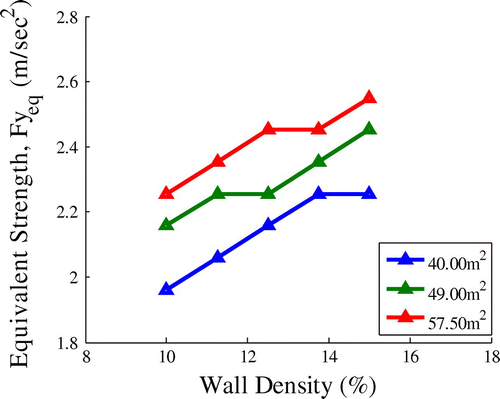
where floor represents the total covered floor area; structural wall density is the ratio of in-plane wall’s cross sectional area to the floor area. Considering the above facts, an attempt is made to select wide case study structures considering the differences in the mechanical properties and structural configuration as random variables in the considered region. The available data on the material and geometric characteristics of brick masonry and stone masonry structures are selected from different available literature, mainly (Ali, Citation2006; Ali et al., Citation2010; Ali & Muhammad, Citation2007; Javed, Citation2008; Naseer et al., Citation2010), reported in Table for the present study, however approximations are made in case of the absence of detailed information where conservative values are adopted.
Table 1. Structural properties considered to generate proto type structural models for masonry structures
where fu,mc represents the masonry characteristic compressive strength; ft represents the tensile strength of masonry; Eeff represents the effective (50 percent cracked) modulus of elasticity; Geff represents the effective (50 percent cracked) shear modulus; γm represents the specific weight of masonry; Wd represents the wall density, ratio of cross sectional area of in-plane walls to the floor area, of a structural models; Af represents the floor area of structural model.
4.2.2. Derivation of capacity curves for case study structures
The case study structural models are designed using equivalent frame method, as discussed earlier. For each material type 50 structural models are prepared and assigned with the characteristic properties given in Table . The 2D structural models are designed conservatively with shear failure and storey mechanism, at the ground floor, whereas the torsional response is not considered. Uniform loading pattern is conservatively considered for nonlinear static pushover analysis. Figure shows the capacity curves of the case study structures, where mean and upper (95th percentile) and lower (5th percentile) bound curves are highlighted and reported in Table . The first drop in the lateral strength is due to the shear failure of masonry piers between window-window while the second drop is due to the shear failure of piers between window-door. The period of vibration is obtained through modal analysis for the first predominant vibration mode.
Figure 15. Pushover curves for case study two-storey low-rise structures and the derivation of capacity curves parameters.

Table 2. Capacity curve parameters (median, lower and upper bound) for case study masonry structures
4.2.3. Parametric study to quantify record-to-record variability in mechanical models
The capacity curve parameters obtained in the above section takes explicitly into consideration the measure of uncertainties due to geometric variability and material uncertainty. However, the derivation of capacity curve made the consideration of uniform lateral loading pattern for pushover analysis. Additional uncertainties can arise in the capacity parameters considering real accelerograms and base excitations. Thus, the case study structural models are analyzed dynamically using nonlinear time history analysis (NLTHA) with ten natural accelerograms extracted from the PEER NGA database for stiff soil condition with the mean spectrum compatible to EC8 Type I C-soil spectrum, see Figure . for the spectral shape and Figure for details of each time history. The accelerograms are previously selected and used elsewhere (Menon & Magenes, Citation2011), however in the present study all the accelerograms are anchored to a common PGA level thus resulting in different scaling factors than the previously used.
Figure 16. Mean spectrum of the selected accelerograms and comparison with the EC8 Type I-C soil spectrum.
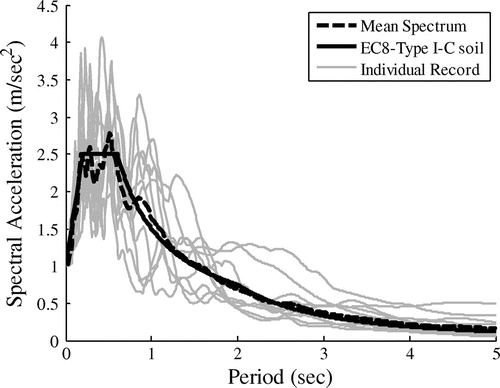
NLTHA of case study structures are performed and for each of the accelerograms the equivalent base shear and equivalent displacement demand on structure are obtained using the proposed SDOF derivation of (Priestley, Citation1985). However the deformed shape of the structure used in the SDOF derivation is obtained from the dynamic analysis of the structure in order to take in to account the record-to-record variability in the capacity parameter. The dynamically derived SDOF system is used to obtain the secant period of the structure.(16)
(16)
(17)
(17)
(18)
(18)
(19)
(19)
where ∆eq represents the equivalent displacement of structural system at the center of seismic force; VBeq represents the equivalent base shear for the corresponding SDOF system; mi represents the floor lumped mass; ∆i represents the floor displacement demand (obtained from NLTHA); VB represents the base shear demand; Meq represents the equivalent mass i.e. structure seismic mass, of the structural system.
The consideration of record-to-record variability in the limit states displacement capacity include the determination of displacement coefficients k1 and k2 in Equation (3) which converts the MDOF system to SDOF system and compute the displacement capacity at the center of seismic force. The effective height of the system is obtained using the following model proposed of Priestley et al. (Priestley et al., Citation2007).
(20)
(20)
where He represents the effective height of the SDOF system, which corresponds to the center of seismic force; Hi represents the floor height; mi represents the floor mass; ∆i represents the floor displacement demand for a given NLTHA. The displacement coefficient at yield limit state (k1) is obtained then by dividing He over the total height of the structural model, HT.
The estimation of k2 includes the incremental dynamic analysis to exceed the collapse limit state of the structure through linear scaling of accelerograms. The data is analyzed to obtain the equivalent displacement demand when the target ultimate interstorey drift is exceeded at any storey, which corresponds to the collapse limit state of structural model. In the next step Equation (3) is used, inverting and re-arranging, to obtain k2.
(21)
(21)
where ∆LS represents the equivalent displacement at the near collapse limit state of structural model; ∆y represents the equivalent displacement at the yielding limit state; θp represents the plastic interstorey drift demand, hS represents the interstorey height. The maximum total uncertainties observed can reach up to 0.30 for displacement coefficients and 0.20 for secant vibration period. The measure of total uncertainties take into accounts the material and geometric uncertainties besides the record-to-record variability.
4.3. Fragility functions derivation
The methodologies mentioned earlier are used to derive different classes of fragility functions, mainly in terms of inelastic spectral displacement, PGA and spectral acceleration at 0.30 s. The following section describes briefly the derivation of global and local fragility functions for case study masonry structures.
4.3.1. Global mechanism
Controlled Monte Carlo simulation is used to generate random structures, 10,000 are considered herein for a given class, with different geometric and mechanical properties considering lognormal probability density function (pdf) for all the parameters involved in the capacity evaluation, as obtained in the previous section. The lognormal pdf is considered for simplicity reasons and to be conservative in structural capacity estimation. The damage scale developed at the Earthquake Engineering Center of Peshawar for different masonry units type are used to derive fragility functions for global limit states of structures (Ali et al., Citation2010; Javed, Citation2008). In the pre-yield condition, the cracking limit state is also considered when the force demand on masonry walls attained is 60 percent of the maximum lateral strength of walls (Tomazevic, Citation1999).
The inter storey drift limits are obtained for each of the individual structural system in the random generation. The drift limit corresponding to DS1 (first limit state at the attainment of 60 percent shear strength force in the storey) is obtained by computing the storey stiffness (50 percent cracked) and the cracking storey shear strength (60 percent of the maximum strength); DS2 (yielding limit state) is obtained similarly at the development of full yielding force at the story level; DS3 (maximum damage state) is considered as ¾ of the ultimate drift limit, however a 10 percent reduction is made in order to be conservative; DS4 (ultimate damage state: collapse of the system) is computed using the FMMC ductility model developed at the university of Pavia. The damage state without any damage in the system i.e. pre-cracked condition, will be referred to as DS0.
It is worth to mention that the FMMC model is particular developed for solid fired brick units and cement mortar, which is further modified (reduction is made conservatively) based on the performance prediction of the tested structure. However, the concept can be reasonably generalized for an unreinforced pressure material like masonry i.e. the ductility capacity reduces with increasing pre-compression on the masonry walls. The drift limits are reported in Table for the case study. The drift limits reported herein are for the damage states being observed in masonry walls at a given storey, ground floor in the represent case, while the drift limits for the case of weak spandrels are not considered due to the fact that masonry spandrels significantly damaged do not jeopardize the global stability of structures and thus cann’t lead to the total collapse of the structure (in most general cases). This such structural systems are not important from the human casualty estimation stand point but nevertheless important for the economic loss estimation.
Table 3. Drift limits computed for case study masonry structures, in percent
4.3.2. Local mechanism
The strength and displacement-controlled out-of-plane mechanical models, as discussed earlier, is used for the derivation of collapse fragility functions of facade walls. The limit state displacement capacity of out-of-plane mechanical model is adopted from Doherty et al. (Citation2002), however the ultimate displacement capacity of wall is considered with reduction factor (ψ) in order to be conservative in capacity evaluation (Lagomarsino & Magenes, Citation2009; Restrepo-Velez, Citation2004). Following dynamic investigation analysis on the out-of-plane failure modes of façade walls (Lagomarsino & Magenes, Citation2009), a reduction factor (ϕ) is proposed for the collapse multiplier obtained using rigid block behavior of out-of-plane responding wall for the estimation of collapse multiplier, the analytical formulation as discussed earlier. To avoid the complexity in using the available analytical models for strength evaluation i.e. collapse multiplier, and increase the confidence level in out-of-plane assessment and to generalize the assessment for regional scale, the collapse multiplier obtained experimentally (Restrepo-Velez & Magenes, Citation2009) is used herein which is obtained through laboratory tests on large number of structural models considering all the prevailing mechanisms and dry masonry structures, see Figure for the likelihood of collapse multiplier for all the common out-of-plane failure modes.
Figure 17. Collapse multiplier for typical out-of-plane failure of façade walls obtained experimentally (Restrepo-Velez & Magenes, Citation2009).
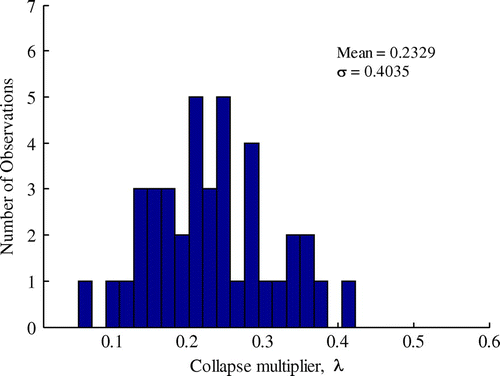
It is mentioned earlier that the resistance of local out-of-plane mechanism to earthquake excitation is by large part governed by the wall geometry, boundary condition, selfweight and pre-compression level of rocking portion of wall while less affected by the masonry material properties (Griffith et al., Citation2003). However, it has not be misperceived that out-of-plane failure modes have the same fragility functions regardless of the masonry typology and region, which may be distinct. This can be understood considering an out-of-plane failure mode being observed in a brick masonry structure or stone masonry structure (both has different in-plane stiffness and strength thus results in different seismic demand on out-of-plane walls due to the filtering effect of ground motion by in-plane walls and floors) which will have different demand on the out-of-plane walls thus resulting in different level of ground motion intensity for the collapse and hence different fragility function functions. However considering the collapse probability (fragility function) correlated with inelastic displacement demand may result in similar fragility functions given that the thickness of walls and the amount of mortar degradation is similar i.e. the limit state displacement capacity is the same for walls.
The parameters involved in the in-plane/out-of-plane mechanical models are generated through Monte Carlo simulation given the mean, coefficient of variation and the distribution type in order to defined structures on regional scale with predominant out-of-plane failure modes. Table reports the parameter values considered for the cases study structures. The drift limits for the global assessment and fragility functions are considered as computed, as given in Table .
Table 4. Parameters used in the random generation of structures for fragility functions derivation for South-Asia countries
4.3.2.1. Vector seismic intensity-based fragility functions (inelastic spectral displacement)
The derivation of fragility functions for vector-based seismic intensity measure included the inelastic displacement demand on the mean capacity curve of a given structural class, obtained in an iterate fashion, for random linear 5 percent damped elastic displacement response spectrum. This includes the limit states capacity demand comparison at the secant vibration period, considering overdamped spectrum, where overdamping is performed using the spectral damping factor proposed by EC8 (Comite Europeen de Normalisation, Citation1994) and the system viscous damping obtained experimentally, discussed earlier.
(22)
(22)
where η represents the spectral overdamping factor; ξeq represents the structures viscous damping, Equation (23). The present study used the viscous damping for masonry structure developed based on the quasi-static cyclic tests performed on masonry walls by the Earthquake Engineering Center of Peshawar.
(23)
(23)
where the functional form of viscous damping makes the consideration recommended by Priestley et al. (Citation2007). The above damping model considered 2 percent elastic damping in addition to the hysteretic damping due to nonlinear response, which is not included in the earlier version of the model where 0.32 is replaced with 0.27 (Ahmad et al., Citation2010b).
The analytical fragility functions derived for the considered structures are reported in Figure to Figure and the parameters for the distribution functions (lognormal function is considered due to its ease in future applications and in order to be conservative in risk assessment) are reported in Tables –.
Figure 18. Vector-based fragility functions for case study masonry structures.
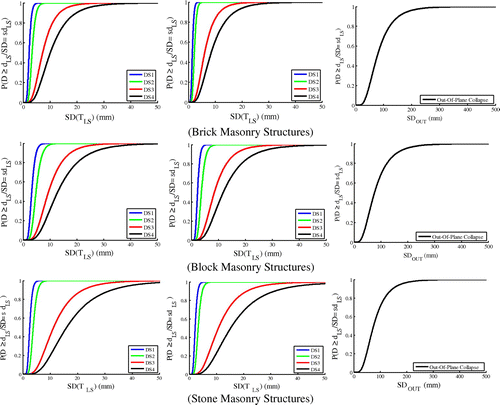
Figure 19. Scalar-based, SA (0.30 s), fragility functions for case study masonry structures.
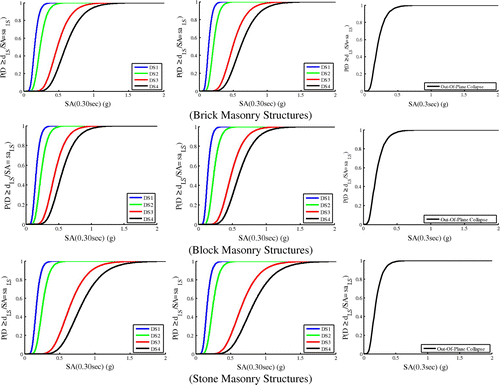
Figure 20. Scalar-based, PGA, fragility functions for case study masonry structures.
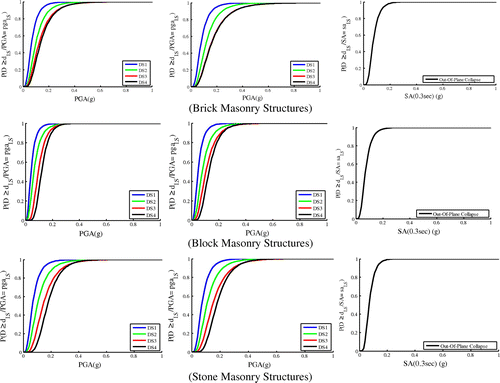
Figure 22. Percentage of structures damaged during 2005 Kashmir earthquake.
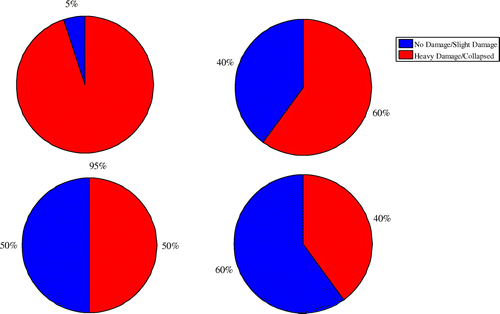
Table 5. Input parameters for vector-based (inelastic spectral displacement) fragility functions, lognormal distribution is conservatively considered
Table 6. Input parameters for scalar-based (elastic spectral acceleration), SA (0.30 s), fragility functions, lognormal distribution is conservatively considered
Table 7. Input parameters for scalar-based (peak ground acceleration) fragility functions, lognormal distribution is conservatively considered
4.3.2.2. Scalar seismic intensity-based fragility functions (SA [0.30 s], pga)
To facilitate different users and case study future applications, fragility functions in terms of scalar seismic intensity are also derived. This mainly included the spectral acceleration at 0.30 s and the peak ground acceleration. The spectral shape considered for the fragility function derivation is essentially considered linear for the case of spectra acceleration seismic intensity and a code-based spectral shape (EC8 Type I for soil type D is adopted) is considered for PGA seismic intensity.
4.4. Test of fragility functions
The methodology used herein for the development of mechanical models and fragility functions for masonry structures is tested against the real observation during the recent earthquake of Kashmir 2005 in Pakistan. This included the development of damage scenario for the case study structures within the earthquake-damaged area. The damaged probability matrix reported and the exposure of the building stock is obtained from (Ali, Citation2007; Naeem et al., Citation2005; Naseer et al., Citation2010) during the EERI field mission in the earthquake affected region which is considered as a reference for the comparison. Detailed and reliable data is not available on the actual observed ground motions in nearby areas. Thus, the ground motions are simulated for the cases study earthquake using the global empirical ground motion predictions equation (GMPE) of NGA (Boore & Atkinson, Citation2008).
The Kashmir earthquake had moment magnitude of 7.2 that struck most of the northern areas of Pakistan on 8 October 2005 at 08:50AM local time (USGS, 2005). The epicenter of the main earthquake shock was located at Latitude 34.49 N and Longitude 73.63E, approximately 19 km north east of Muzaffarabad city of Azad Jammu Kashmir. The earthquake event is the direct results of collision of the Indian plate, moving 40–50 mm/yr northward, with the Eurasian plate. The collision is crust-to-crust and thus produces large magnitude shallow earthquakes. In this earthquake, more than 780,000 buildings were either destroyed or damaged beyond repair and more rendered unusable that needed demolishment and replacement (Earthquake Engineering Research Institute, Citation2006). The destruction was observed over an area of 30,000 km2 within rupture distance of about 15 to 30 km causing sever loss of life 80,000 and property 5.8 USD.
The scalar seismic intensity-based, SA (0.30 s), fragility functions of case study structures developed herein are used for the damage scenario development. The vector-based fragility functions, which are although recommended for scenario, based loss estimation, is less convenient and cumbersome from computational stand point whereas the scalar fragility functions can provide a direct measure and which can be used later for loss estimation using probabilistic approaches with high confidence and computational ease. The ground motions are computed for type D NEHRP soil with shear wave velocity of 250 m/s, considering the uncertainties in ground motions estimation. Figure reports the simulated ground motions in the affected region and the comparison between the predicted (median values are selected) and the observed damage scenario, which shows a reasonable efficiency of the UPAV methodology for damage scenario prediction.
Figure 23. Test and validation of the UPAV methodology against the 2005 Kashmir earthquake.
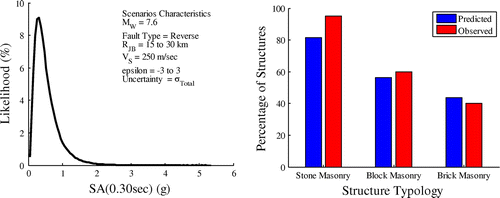
It is worth to mention that the case study damage scenario considers stone masonry with in-plane mechanism being 20 percent (representing urban structures) and with out-of-plane mechanism being 80 percent (rural structures), which was the exposure of stone masonry structures subjected to Kashmir earthquake (Ali, Citation2007).
5. Conclusions
The paper presents a European standard methodology DBELA for the derivation of analytical capacity curves and fragility functions for masonry structures in Pakistan mainly brick masonry, stone masonry and block masonry structures. This included the derivation of capacity curves, through nonlinear static pushover analysis, of prototype of structural models designed, through the use of available masonry shear wall strength deformability constitutive models and the ductility model, to respect the regional characteristics of case study structures.
The study categorized masonry structures, for given material types, in three classes: masonry structures with reinforced concrete floors and roof having predominant global in-plane earthquake response mechanism, masonry structures with light wooden floors and roof truss having ties and/or ring beams with in-plane mechanism. A total of 450 low-rise masonry structures, 50 for each class with due consideration of geometric and material uncertainties, were designed and analyzed through pushover analysis for each of the region. Capacity curves and limit state displacement capacities were obtained for each class of structures, the median capacity curve is established with the lower and upper bound capacity curves which can be used for the damage assessment of the case study structures. Additionally, nonlinear dynamic time history analysis of the structural models is carried out to quantify the uncertainties introduced in the displacement and secant period models, which generally increases the level of total uncertainties, by different earthquakes.
The DBELA methodology is used for the derivation of analytical fragility functions correlated with the vector-based and scalar-based seismic intensities of ground motions. The input parameters of the fragility functions, considered conservatively as lognormal, are reported for future applications. The methodology and the derived capacity curves and fragility functions are tested against the recent 2005 Kashmir earthquake in developing the damage scenario, in predicting the number of structure with heavy damage and collapse. This included the simulations of scenario ground motions using empirical ground motion prediction equation, with due consideration of uncertainties, and the estimation of damage and collapse probability using the scalar-based, SA (0.30 s), fragility functions which shows reasonable agreement with the observation and positively shows the better performance of scalar intensity, SA (0.30 s), for scenario-based loss estimation. The derived fragility functions can be used for seismic risk assessment of masonry structures for future applications within the context of rapid response to earthquakes, earthquake preparedness and planning and decision-making in the region.
It is worth to mention that numbers of approximations have been made in the present research in modeling and analysis of the considered urban masonry typologies due to the unviability of typology-specific material data. It is worth to mention that the focus of present research is primarily to list procedures how to derive fragility functions for both in-plane and out-of-plane failure mechanisms of masonry buildings using displacement-based method. The derived fragility functions may be further improved given the typology-specific data.
Additional information
Funding
Notes on contributors
Naveed Ahmad
Naveed Ahmad completed his PhD in Earthquake Engineering from ROSE School, IUSS Pavia, Italy. Presently, serving as assistant professor and postgraduate advisor of Earthquake Engineering in the Department of Civil Engineering of University of Engineering and Technology Peshawar. He is involved in experimental and analytical research in the field of earthquake engineering; including shake table testing, quasi-static cyclic testing, development and application of inelastic structural analysis tools, performance-based assessment of structures, seismic vulnerability and risk assessment, and earthquake loss estimation.
Qaisar Ali
Qaisar Ali is professor of Structural & Earthquake Engineering in the Department of Civil Engineering of University of Engineering and Technology Peshawar. He has been actively involved in teaching and research for more than 20 years. He has served as head of technical core group for development of Building Code of Pakistan. His research primarily focuses on the vulnerability assessment and retrofitting of structures against earthquake loading.
References
- Abrams, D. P. (2001). Performance-based engineering concepts for unreinforced masonry building structures. Progress in Structural Engineering and Materials, 3(1), 48–56.10.1002/(ISSN)1528-2716
- Asian Development Bank and World Bank. (2005). Pakistan 2005 earthquake: Preliminary damage and needs assessment (Technical Document). Islamabad: Author.
- Ahmad, N. (2011) Seismic risk assessment and loss estimation of regional building stock of Pakistan ( PhD Thesis). Pavia: ROSE School-IUSS Pavia.
- Ahmad, N., Crowley, H., Pinho, R., & Ali, Q. (2010a). Displacement-based earthquake loss assessment of masonry buildings in Mansehra City, Pakistan. Journal of Earthquake Engineering, 14(S1), 1–37.
- Ahmad, N., Crowley, H., Pinho, R., & Ali, Q. (2010b). Derivation of displacement-based fragility functions for masonry buildings. Proceedings of the fourteenth european conference on earthquake engineering Ohrid Macedonia.
- Ahmad, N., Crowley, H., Pinho, R., & Ali, Q. (2011). Frame-elements constitutive law for nonlinear static and dynamic analyses of masonry buildings. In S. O. Cheung, F. Yazdani, N. Ghafoori, & A. Singh (Eds.), Modern Methods and Advances in Structural Engineering and Construction. Singapore: Research Publishing Service.
- Ali, Q. (2006). Unreinforced brick masonry residential building. In World housing encyclopedia (Report No. 112). Oakland, CA: Earthquake Engineering Research Institute.
- Ali, Q. (2007). Case study of Pakistan housing reconstruction (Invited Seminar Presentation). Pavia: ROSE School-IUSS Pavia.
- Ali, Q., & Muhammad, T. (2007). Stone masonry residential buildings. In World Housing Encyclopedia (Report No. 138). Oakland, CA: Earthquake Engineering Research Institute.
- Ali, Q., Naeem, A., Ashraf, M., Ahmed, A., Alam, B., Fahim, M., & Rahman, S. (2010). Shaking table test on typical stone masonry buildings used in the Himalayan belt. Proceedings of the ninth US and tenth Canadian conference on earthquake engineering, Toronto.
- Ambraseys, N., Lensen, G., & Moinfar, A. (1975). The Pattan earthquake of 28 December 1974. UNESCO field mission report, FMR/SC/CEO/75/134 (1975), Paris.
- Bal, I. E. (2008). Displacement-based earthquake loss assessment: Method development and application to Turkish building stock (PhD Thesis). Pavia: ROSE School-IUSS Pavia.
- Bal, I. E., Crowley, H., Pinho, R., & Gulay, G. (2008). Detailed assessment of structural characteristics of Turkish RC building stock for loss assessment models. Structural Dynamics and Earthquake Engineering, 28, 914–932.10.1016/j.soildyn.2007.10.005
- Benedetti, D., & Tomazevic, M. (1984). Sulla verifica sismica di construzioni in muratura [On the seismic assessment of masonry structures]. Ingegneria Sismica, I, 9–16.
- Bommer, J. J. Pinho, R. & Crowley, H. (2006). Using a displacement-based approach for earthquake loss estimation. In S. T. Wasti, & G. Ozcebe (eds.): Advances in earthquake engineering for urban risk reduction (pp. 489–504). Dordrecht: Springer.10.1007/1-4020-4571-9
- Bommer, J. J., Spence, R., Erdik, M., Tabuchi, S., Aydinoglu, N., Booth, E., … Peterken, O. (2002). Development of an earthquake loss model for Turkish catastrophe insurance. Journal of Seismology, 6(3), 431–446.10.1023/A:1020095711419
- Boore, D. M., & Atkinson, G. M. (2008). Ground-motion prediction equations for the average horizontal component of PGA, PGV, and 5%-damped PSA at spectral periods between 0.01s and 10.0s. Earthquake Spectra, 24(1), 99–138.10.1193/1.2830434
- Borzi, B., Crowley, H., & Pinho, R. (2008). Simplified pushover-based earthquake loss assessment (SP-BELA) method for masonry buildings. International Journal of Architectural Heritage, 2, 353–376.10.1080/15583050701828178
- Borzi, B., Pinho, R., & Crowley, H. (2008). Simplified pushover-based vulnerability analysis for large-scale assessment of RC buildings. Engineering Structures, 30, 804–820.10.1016/j.engstruct.2007.05.021
- Building Code of Pakistan. (2007). Seismic provisions. Islamabad: Ministry of Housing and Works.
- Calvi, G. M. (1999). A displacement-based approach for vulnerability evaluation of classes of buildings. Journal of Earthquake Engineering, 3, 411–438.
- Comite Europeen de Normalisation. (1994). Eurocode8: Design provisions for earthquake resistance of structures. Part1–1: General rules–Seismic actions and general requirements for structures, prEN 1998-1-1. Brussels: Author.
- Crowley, H., & Bommer, J. J. (2006). Modelling seismic hazard in earthquake loss models with spatial distributed exposure. Bulletin of Earthquake Engineering, 4(3), 249–273.10.1007/s10518-006-9009-y
- Crowley, H., Pinho, R., & Bommer, J. J. (2004). A probabilistic displacement-based vulnerability assessment procedure for earthquake loss estimation. Bulletin of Earthquake Engineering, 173–219.10.1007/s10518-004-2290-8
- Crowley, H., Pinho, R., Bommer, J. J., & Bird, J. F. (2006). Development of a displacement-based method for earthquake loss assessment (DBELA) (Technical Report). Pavia: IUSS Press.
- D’Ayala, D. F., & Paganoni, S. (2011). Assessment and analysis of damage in L’Aquila historic city center after 6th April 2009. Bulletin of Earthquake Engineering, 9(1), 81–104.10.1007/s10518-010-9224-4
- D’Ayala, D. F., & Speranza, E. (2003). Definition of collapse mechanisms and seismic vulnerability of historic masonry buildings. Earthquake Spectra, 19, 479–509.10.1193/1.1599896
- Doherty, K., Griffith, M. C., Lam, N., & Wilson, J. (2002). Displacement-based seismic analysis for out-of-plane bending of unreinforced masonry walls. Earthquake Engineering and Structural Dynamics, 31, 833–850.10.1002/(ISSN)1096-9845
- Earthquake Engineering Research Institute. (2006). Learning from earthquakes: The Kashmir earthquake of October 8, 2005: Impacts in Pakistan (EERI Special Earthquake Report). Oakland, CA: Author.
- Emori, K., & Schnobrich, W. C. (1974). Analysis of reinforced concrete frame-wall structures for strong motion earthquakes (Structural Research Series No. 434). Champaign, IL: Civil Engineering Studies, University of Illinois at Urbana-Champaign.
- Federal Emergency Management Agency. (2003). HAZUS-MH: Earthquake loss estimation methodology (Technical Manual). Washington, DC: Author.
- Frocht, M. M. (1931). Recent advances in photoelasticity. Transactions of ASME, 55, 135–153.
- Frumento, S., Magenes, G., Morandi, P., & Calvi, G. M. (2009). Interpretation of experimental shear tests on clay brick masonry walls and evaluation of q-factor for seismic design (Technical Report). Italy: IUSS Press.
- Galasco, A., Magenes, G., Penna, A., & Da-Pare, M. (2010). In-plane cyclic shear tests of undressed double leaf stone masonry panels. Proceedings of the 14th European Conference on Earthquake Engineering, Ohrid.
- Glaister, S., & Pinho, R. (2003). Development of a simplified deformation-based method for seismic vulnerability assessment. Journal of Earthquake Engineering, 7, 107–140.
- Griffith, M. C., Magenes, G., Melis, G., & Picchi, L. (2003). Evaluation of out-of-plane stability of unreinforced masonry walls subjected to seismic excitation. Journal of Earthquake Engineering, 7, 141–169.
- Javed, M. (2008). Seismic risk assessment of unreinforced brick masonry building system of northern Pakistan ( PhD Thesis). Civil Engineering Department, NWFP University of Engineering and Technology, Peshawar.
- Kappos, A. J., Penelis, G. G., & Drakopoulos, C. G. (2002). Evaluation of simplified models for lateral load analysis of unreinforced masonry buildings. Journal of Structural Engineering, 128(7), 890–897.10.1061/(ASCE)0733-9445(2002)128:7(890)
- Khan, M. A. (2007). Disaster preparedness for natural hazards: Current status in Pakistan (Technical Report). Kathmandu: International Centre for Integrated Mountain Development (ICIMOD).
- Kircher, C. A., Nassar, A. A., Kustu, O., & Holmes, W. T. (1998). Development of building damage functions for earthquake loss estimation. Earthquake Spectra, 13(4), 663–682.
- Lagomarsino, S., & Magenes, G. (2009). Evaluation and reduction of the vulnerability of masonry buildings, G. Manfredi & M. Dolce (Eds.) The state of earthquake engineering research in Italy: The ReLUIS-DPC 2005-2008 Project (pp. 1–50). Napoli: Doppiavoce.
- Magenes, G. (2000). A method for pushover analysis in seismic assessment of masonry buildings. Proceedings of the 12th world conference on earthquake engineering, Auckland.
- Magenes, G. (2006). Masonry building design in seismic areas: Recent experiences and prospects from a European standpoint. Proceedings of the first European conference on earthquake engineering and seismology keynote 9, Geneva.
- Magenes, G., Bolognini, D., & Braggio, C. (2000). Metodi semplificati per l’analisi sismica non linear di edifici in muratura (Technical Report). Roma: CNR-Gruppo Nazionale per al Difesa dai Terremoti (GNDT).
- Magenes, G., & Calvi, G. M. (1997). In-plane seismic response of brick masonry walls. Earthquake Engineering and Structural Dynamics, 26, 1091–1112.10.1002/(ISSN)1096-9845
- Magenes, G., Calvi, G. M., & Kingsley, G. R. (1995). Seismic testing of a full-scale two-storey masonry building: Test procedure and measured experimental response (Technical Report). Pavia: Structural Mechanics Department, University of Pavia.
- Magenes, G., & Fontana, D. (1998). Simplified non-linear seismic analysis of masonry buildings. Proceeding of the British Masonry Society, 8, 190–195.
- Magenes, G., & Morandi, P. (2008). Some issues on seismic design and assessment of masonry buildings based on linear elastic analysis. Proceedings of the Michael John Nigel Priestley Symposium. Pavia: IUSS Press.
- Maqsood, S. T., & Schwarz, J. (2008). Seismic vulnerability of existing building stock in Pakistan. 14th World Conference on Earthquake Engineering, Paper ID: 09-01-0122, Beijing.
- Maqsood, S. T., & Schwarz, J. (2010). Building vulnerability and damage during the 2008 Baluchistan earthquake in Pakistan and past experiences. Seismological Research Letters, 81(3), 514–525.10.1785/gssrl.81.3.514
- McKenna, F., Fenves, G. L., & Scott, M. H. (2010). Open system for earthquake engineering simulation (OpenSees): Version2.2.2. Berkeley, CA: PEER . Retrieved from http://opensees.berkeley.edu
- Menon, A., & Magenes, G. (2011). Definition of seismic input for out-of-plane response of masonry walls: I. Parametric study. Journal of Earthquake Engineering, 15(2), 165–194.10.1080/13632460903456981
- Morandi, P., & Magenes, G. (2008). Seismic design of masonry buildings: Current procedures and new perspectives. Proceedings of the fourteenth world conference on earthquake engineering Beijing.
- Naeem, A., Ali, Q., Javed, M., Hussain, Z., Naseer, A., Ali, S. M., … Ashraf, M. (2005). A summary report on Muzaffarabad earthquake, Pakistan (Technical Report). Peshawar: Earthquake Engineering Center.
- Naseer, A., Khan, A., Hussain, Z., & Ali, Q. (2010). Observed seismic behavior of buildings in northern Pakistan during the 2005 Kashmir earthquake. Earthquake Spectra, 26(2), 425–449.10.1193/1.3383119
- Otani, S. (1974). SAKE, a computer program for inelastic response of R, C frames to earthquakes (Report UILU-Eng-74-2029). Champaign, IL: Civil Engineering Studies, University of Illinois at Urbana-Champaign.
- Penna, A. (2005). Seismic vulnerability assessment of masonry structures. Earthquake Rehabilitation Conference, Islamabad, Pakistan.
- Priestley, M. J. N. (1985). Seismic behavior of unreinforced masonry walls. Bulletin of the New Zealand National Society for Earthquake Engineering, 18(2), 191–205.
- Priestley, M. J. N., Calvi, G. M., & Kowalsky, M. J. (2007). Displacement-based seismic design of structures. Pavia: IUSS Press.
- Restrepo-Velez, L. F. (2004). Seismic risk of unreinforced masonry buildings ( PhD Thesis). ROSE School-IUSS Pavia, Pavia.
- Restrepo-Velez, L. F., & Magenes, G. (2004). Simplified procedure for the seismic risk assessment of unreinforced masonry buildings. Proceedings of the thirteenth world conference on earthquake engineering Vancouver.
- Restrepo-Velez, L. F., & Magenes, G. (2009). Static tests on dry stone masonry and evaluation of static collapse multiplier (Technical Report). Pavia: IUSS Press.
- Rilem, T. C. (1994). Diagonal tensile strength tests of small wall specimens, 1991. In RILEM, recommendations for the testing and use of constructions materials 1994. London.
- Rossetto, T., & Peiris, N. (2009). Observations of damage due to the Kashmir earthquake of October 8, 2005 and study of current seismic provisions for buildings in Pakistan. Bulletin of Earthquake Engineering, 7(3), 681–699.10.1007/s10518-009-9118-5
- Tassios, T. P., & Syrmakezis, K. (2002). Load-bearing stone masonry buildings. In World Housing Encyclopedia (Report No. 16). Oakland, CA: Earthquake Engineering Research Institute (EERI).
- Tomazevic, M. (1999). Earthquake-resistant design of masonry buildings-innovation in structures and construction (Vol. 1). London: Imperial College Press.
- Xue, Q., Wu, C. W., Chen, C. C., & Chou, W. Y. (2009). Post-earthquake loss assessment based on structural component damage inspection for residential RC buildings. Engineering Structures, 31, 2947–2953.10.1016/j.engstruct.2009.07.022
- Zaman, S., & Warnitchai, P. (2010). Probabilistic seismic hazard maps for Pakistan. Proceedings of the third Asian conference on earthquake engineering, Bangkok, Paper No. ACEE-P-026.

